
New Delhi
The number of new cars registered on the government’s VAHAN portal rose to a record 41,53,432 units during the financial year ended March 31, 2025, which represents a 4.87 per cent increase in sales over the previous financial year, according to figures compiled by the Federation of Automobile Dealers Associations (FADA).
The rural areas registered a higher growth rate of 7.93 per cent driven by higher farms incomes, following the better performance of the agricultural sector. The urban areas clocked a growth of 3.07 per cent.
Maruti Suzuki India continued to be the market leader with a dominant 40 per cent market share while arch rival Hyundai Motor India was locked in fierce competition for the second spot with home-grown Tata Motors and Mahindra & Mahindra Ltd. The two Indian carmakers also made inroads in the electric car segment, according to the data.
Two-wheeler sales during 2024-25 registered a higher growth rate at 7.71 per cent year-on-year to touch 1,88,77,812 units on the back of buoyant demand.
Three-wheelers sales rose 4.54 per cent compared to the previous on driven by higher economic activity but commercial vehicles remained flat during the year.
“FY25 truly showcased how adaptable and resilient India’s auto retail sector can be,” FADA President CS Vigneshwar said in a statement.
“Our initial forecast of low single-digit growth, around 5 per cent, for passenger vehicles ended up hitting the mark almost perfectly. A key highlight for the year was the performance in rural areas," he added.
According to FADA, auto dealers across the country have some apprehensions going ahead in FY26 as “IMD’s warning of intense heatwaves looms over consumer footfall and infrastructure activity, while renewed tariff tensions on the international stage add market volatility and rattle buyer sentiment.”
READ MORE: With reforms, India could turn US-triggered tariff crisis into an opportunity
However, despite these headwinds, nearly half of surveyed dealers still expect April sales to be flat and over a third foresee some growth—driven by regional festivals and the marriage season, the FADA statement added.
